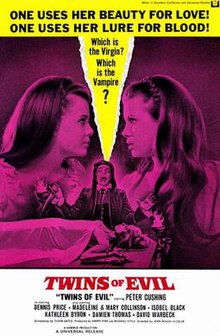
Carmilla is an 1872 Gothic novella by Irish author Sheridan Le Fanu and one of the early works of vampire fiction, predating Bram Stoker's Dracula (1897) by 25 years. First published as a serial in The Dark Blue (1871–72), the story is narrated by a young woman preyed upon by a female vampire named Carmilla, later revealed to be Mircalla, Countess Karnstein. The character is a prototypical example of the lesbian vampire, expressing romantic desires toward the protagonist. The story is often anthologised, and has been adapted many times in film and other media.
Hammer Film Productions Ltd. is a British film production company based in London. Founded in 1934, the company is best known for a series of Gothic horror and fantasy films made from the mid-1950s until the 1970s. Many of these involve classic horror characters such as Baron Victor Frankenstein, Count Dracula, and the Mummy, which Hammer reintroduced to audiences by filming them in vivid colour for the first time. Hammer also produced science fiction, thrillers, film noir and comedies, as well as, in later years, television series.

Vampire films have been a staple in world cinema since the era of silent films, so much so that the depiction of vampires in popular culture is strongly based upon their depiction in films throughout the years. The most popular cinematic adaptation of vampire fiction has been from Bram Stoker's 1897 novel Dracula, with over 170 versions to date. Running a distant second are adaptations of the 1872 novel Carmilla by Sheridan Le Fanu. By 2005, the Dracula character had been the subject of more films than any other fictional character except Sherlock Holmes.
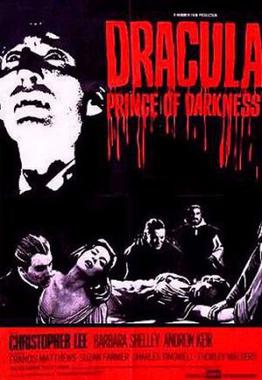
Dracula: Prince of Darkness is a 1966 British gothic supernatural horror film directed by Terence Fisher. The film was produced by Hammer Film Productions, and is the third entry in Hammer's Dracula series, as well as the second to feature Christopher Lee as Count Dracula, the titular vampire. It also stars Andrew Keir, Francis Matthews, and Barbara Shelley.

The Brides of Dracula is a 1960 British supernatural horror film produced by Hammer Film Productions. Directed by Terence Fisher, the film stars Peter Cushing, David Peel, Freda Jackson, Yvonne Monlaur, Andrée Melly, and Martita Hunt. The film is a sequel to the 1958 film Dracula, though the character of Count Dracula does not appear in the film, and is instead mentioned only twice. Christopher Lee would reprise his role as Dracula in the next film in the Dracula series, Dracula: Prince of Darkness (1966).
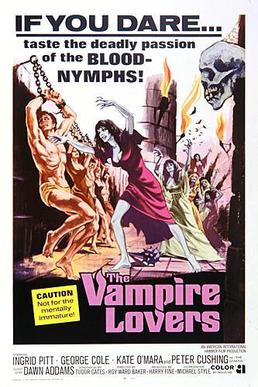
The Vampire Lovers is a 1970 British Gothic horror film directed by Roy Ward Baker and starring Ingrid Pitt, Peter Cushing, George Cole, Kate O'Mara, Madeline Smith, Dawn Addams, Douglas Wilmer and Jon Finch. It was produced by Hammer Film Productions. It is based on the 1872 Sheridan Le Fanu novella Carmilla and is the first film in the Karnstein Trilogy, the other two films being Lust for a Vampire (1971) and Twins of Evil (1971). The three films were somewhat daring for the time in explicitly depicting lesbian themes.

The Satanic Rites of Dracula is a 1973 British horror film directed by Alan Gibson and produced by Hammer Film Productions. It is the eighth film in Hammer's Dracula series, and the seventh and final one to feature Christopher Lee as Dracula. The film was also the third to unite Peter Cushing as Van Helsing with Lee, following Dracula (1958) and Dracula A.D. 1972 (1972).

Lesbian vampirism is a trope in early gothic horror and 20th century exploitation film. The archetype of a lesbian vampire used the fantasy genre to circumvent the heavy censorship of lesbian characters in the realm of social realism.
The Karnstein Trilogy is a series of vampire films produced by Hammer Films. They are notable at the time for their daring lesbian storylines. All three films were scripted by Tudor Gates. They are related by vampires of the noble Karnstein family, and their seat Castle Karnstein near the town of Karnstein in Styria, Austria.
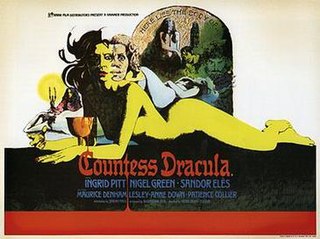
Countess Dracula is a 1971 British Hammer horror film directed by Peter Sasdy and starring Ingrid Pitt, Nigel Green and Lesley-Anne Down. It was produced by Alexander Paal.
Yutte Stensgaard is a Danish actress born in Thisted, Jutland, Denmark, best known for her starring role in Hammer's Lust for a Vampire (1971).

Lust for a Vampire, also known as Love for a Vampire or To Love a Vampire, is a 1971 British Hammer Horror film directed by Jimmy Sangster, starring Ralph Bates, Barbara Jefford, Suzanna Leigh, Michael Johnson, and Yutte Stensgaard. It was given an R rating in the United States for some violence, gore, strong adult content and nudity. It is the second film in the Karnstein Trilogy, loosely based on the 1872 Sheridan Le Fanu novella Carmilla. It was preceded by The Vampire Lovers (1970) and followed by Twins of Evil (1971). The three films do not form a chronological development, but use the Karnstein family as the source of the vampiric threat and were somewhat daring for the time in explicitly depicting lesbian themes.
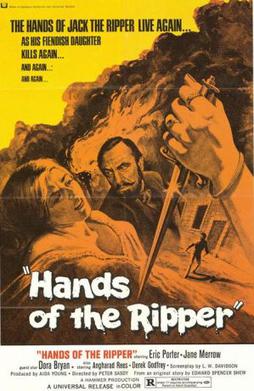
Hands of the Ripper is a 1971 British horror film directed by Peter Sasdy and starring Eric Porter, Angharad Rees and Jane Merrow. It was produced by Aida Young for Hammer Film Productions, and written by L. W. Davidson from a story by Edward Spencer Shew. The film was released in the U.S. as a double feature with Twins of Evil (1971).

Vampire Circus is a 1972 British horror film directed by Robert Young and starring Adrienne Corri, Thorley Walters and Anthony Higgins. It was written by Judson Kinberg, and produced by Wilbur Stark and Michael Carreras (uncredited) for Hammer Film Productions. The story concerns a travelling circus, the vampiric artists of which prey on the children of a 19th century Serbian village.
Katya Wyeth is a former model and actress notable for her roles in several classic horror films of the early 1970s. She was married to British actor Michael Bangerter, with whom she had two children.
Kirsten Lindholm is a former model and a film actress known for her roles in Hammer horror movies, in which she first appeared as Kirsten Betts. She is now a yoga instructor and performer currently living in New Zealand and is now known as Elandra Kirsten Meredith and by the Sikh religious name Vikram Kaur Khalsa.

Malenka, the Vampire's Niece is a 1969 horror film that was written and directed by Spanish director Amando de Ossorio; it was his first horror film.

The Devil's Wedding Night is a 1973 Italian horror film.
Dracula is a British horror film series produced by Hammer Film Productions. The films are centered on Count Dracula, bringing with him a plague of vampirism, and the ensuing efforts of the heroic Van Helsing family to stop him. The original series of films consisted of nine installments, which starred iconic horror actors Christopher Lee and Peter Cushing as Count Dracula and Doctor Van Helsing, respectively. The series is part of the larger Hammer horror oeuvre.
The World of Hammer is a British television documentary series created and written by Robert Sidaway and Ashley Sidaway, and produced by Robert Sidaway.
